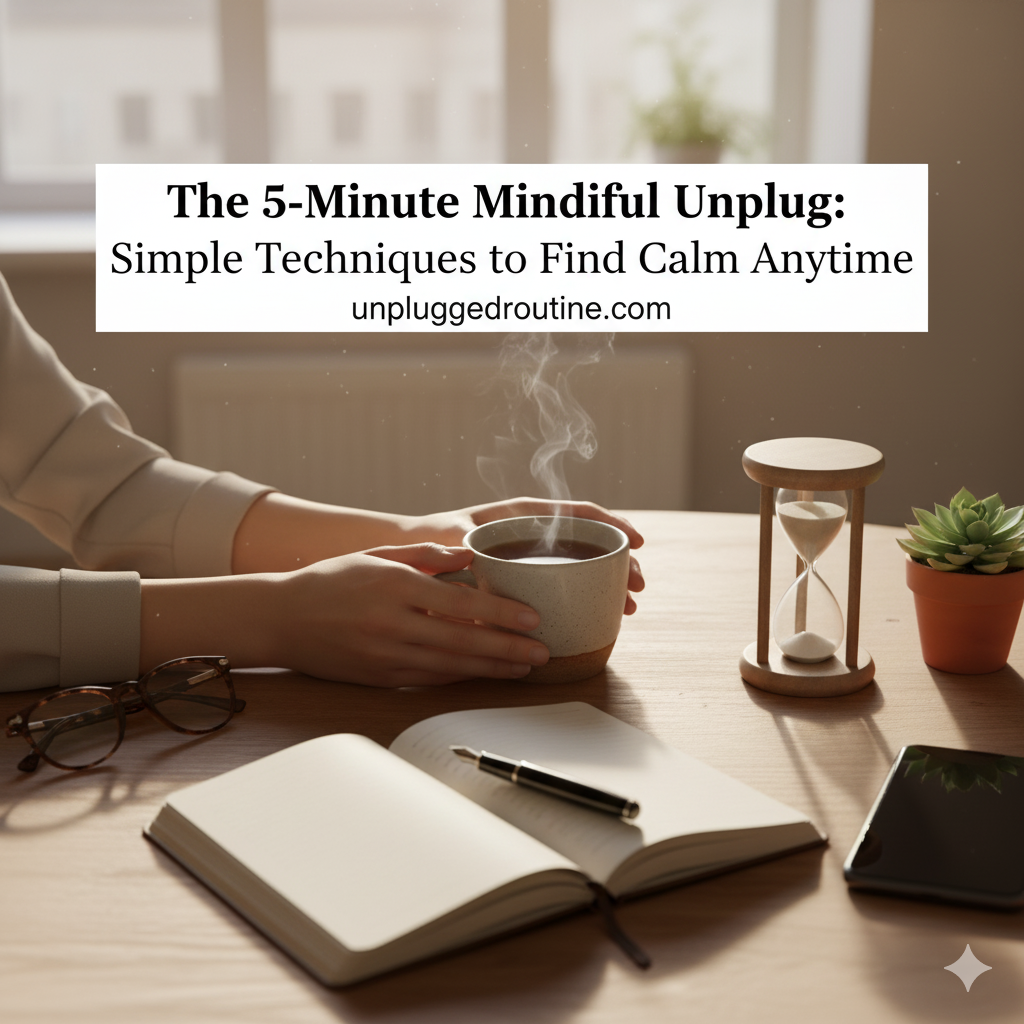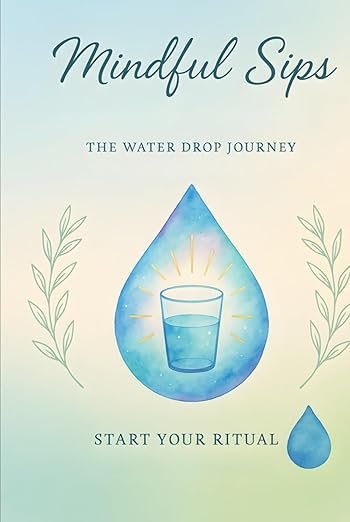Do you ever feel like you’re constantly “on”? Your brain buzzing with notifications, your to-do list looming, and your body tense from the relentless pace of modern life? We’re all searching for that elusive moment of calm, a tiny oasis in the desert of digital overload. But what if I told you that you don’t need to book a retreat or dedicate an hour to meditation?
What if you could hit the “reset” button on your mind in just 5 minutes?
That’s the power of the 5-Minute Mindful Unplug. It’s a collection of simple, accessible techniques designed to bring you back to the present moment, reduce stress, and find genuine calm, no matter where you are or how chaotic things feel. These aren’t just quick fixes; they’re micro-practices that build resilience and foster a more peaceful unplugged routine over time.
Ready to reclaim your peace, one mindful minute at a time? Let’s dive in!

The Modern Dilemma: Why 5 Minutes of Calm is a Game-Changer
In a world that demands constant attention, the idea of a “5-minute unplug” might seem too good to be true. But there’s a profound reason why these short bursts of mindfulness are so effective:
- Combatting Constant Stimulation: Our brains are bombarded with information. A 5-minute break allows your prefrontal cortex (the thinking part of your brain) to rest, reducing decision fatigue and improving focus.
- Breaking the Stress Cycle: Just a few minutes of mindful breathing or sensory engagement can activate your parasympathetic nervous system, the “rest and digest” mode, pulling you out of the chronic stress response.
- Accessibility: “I don’t have time” is the biggest barrier to self-care. Everyone has 5 minutes. These techniques fit seamlessly into busy schedules, making mindfulness sustainable.
- Digital Detox Micro-Dose: Each 5-minute unplug is a mini-break from screens, reducing blue light exposure and the constant draw of digital distractions. It’s a fundamental part of establishing an unplugged routine.
- Building Resilience: Regular, short mindful breaks train your brain to return to a calm state more easily, improving your overall emotional regulation and resilience to daily stressors.
These aren’t just feel-good moments; they are powerful tools for mental and physical well-being.
Your Pocket Guide to Peace: 7 Simple 5-Minute Mindful Unplug Techniques
Here are seven go-to techniques you can deploy anytime, anywhere, to bring yourself back to center. Pick one or two that resonate most with you and try them today!
1. The 5-Sense Scan (5 Minutes)
This is a classic mindfulness exercise that instantly grounds you in the present.
- Find a quiet spot: Sit or stand comfortably.
- Look (1 minute): Notice 5 things you can see. Pay attention to colors, shapes, textures. Look at something you usually overlook, like a pattern on the wall or the dust motes dancing in the sunlight.
- Feel (1 minute): Notice 4 things you can feel. The clothes on your skin, the air temperature, the pressure of your feet on the ground, the texture of the chair.
- Listen (1 minute): Notice 3 things you can hear. Distant traffic, the hum of your computer, your own breathing. Listen without judgment.
- Smell (1 minute): Notice 2 things you can smell. Your coffee, your lotion, the air around you.
- Taste (1 minute): Notice 1 thing you can taste (or the sensation in your mouth). Residual coffee, toothpaste, or simply the sensation of your saliva.
This exercise forces your mind to slow down and focus on immediate sensory input, pulling it away from anxious thoughts.
2. Box Breathing (3-5 Minutes)
A simple yet incredibly effective breathing technique used by Navy SEALs to manage stress under pressure.
- Inhale (4 counts): Slowly breathe in through your nose for 4 seconds, feeling your belly expand.
- Hold (4 counts): Hold your breath for 4 seconds.
- Exhale (4 counts): Slowly breathe out through your mouth for 4 seconds, emptying your lungs.
- Hold (4 counts): Hold your breath again for 4 seconds before the next inhale.
- Repeat: Continue this cycle for 3-5 minutes.
Box breathing calms the nervous system and brings clarity to a frazzled mind.

3. Mindful Sip (2-5 Minutes)
Transform a simple act into a meditative experience. Perfect for your coffee, tea, or even just a glass of water.
- Prepare: Pour your drink.
- Observe: Notice the color, the steam rising, the aroma.
- Feel the warmth: Hold the mug, feel its temperature in your hands.
- Take a small sip: Let the liquid linger on your tongue. Notice the texture, the flavors, how it feels as it goes down.
- Engage fully: Drink slowly, mindfully, for a few minutes, focusing solely on the experience of the drink.
This redirects your attention and provides a moment of simple pleasure.
4. The Gratitude Pause (5 Minutes)
Shift your perspective by actively seeking out things to appreciate.
- Sit comfortably: Close your eyes or soften your gaze.
- List 5 things: Bring to mind 5 things you are genuinely grateful for right now. They can be big (your health) or small (the warmth of your socks).
- Feel the emotion: As you think of each item, really lean into the feeling of gratitude in your body.
- Expand: You can expand this to 5 people, 5 experiences, or 5 aspects of your current environment.
Cultivating gratitude is a powerful mood booster and stress reducer.
5. Nature’s Gaze (5 Minutes)
If you have access to a window or an outdoor space, this is a beautiful way to connect.
- Find a view: Look out a window, step onto a balcony, or sit in your garden.
- Soft gaze: Choose one natural element to focus on—a tree, a cloud, a plant, a bird.
- Observe without judgment: Notice its colors, its movement, its details. Don’t analyze or label; just observe.
- Let your mind rest: Allow your thoughts to drift, but gently bring your attention back to the natural object whenever you notice your mind wandering.
This simple connection to nature can be incredibly restorative, even in brief moments.
6. Mindful Walking (5 Minutes)
Turn your walk from one place to another into a grounding exercise.
- Focus on your feet: Feel the sensation of your feet making contact with the ground. Notice the heel, then the arch, then the ball of your foot and toes.
- Notice your stride: Pay attention to the rhythm of your steps, the swing of your arms, the movement of your body.
- Engage senses: Expand your awareness to the sights, sounds, and smells around you, but keep your primary focus on the physical act of walking.
- Slow down: Try to walk a little slower than your usual pace to truly feel each step.
This transforms a mundane act into a mindful journey.
7. Progressive Muscle Relaxation (5 Minutes)
Release physical tension that often accompanies mental stress.
- Sit or lie comfortably: Close your eyes if safe to do so.
- Focus on a body part: Start with your feet. Tense the muscles in your feet as tightly as you can for 5 seconds.
- Release: Completely relax those muscles, noticing the difference in sensation. Spend 10-15 seconds feeling the relaxation.
- Move up: Continue this process, tensing and relaxing different muscle groups as you move up your body: calves, thighs, glutes, abdomen, chest, arms, hands, shoulders, neck, face.
- Breathe: Remember to breathe deeply throughout the exercise.
This technique is excellent for identifying and releasing hidden tension.
Making the 5-Minute Mindful Unplug a Habit
The key to these techniques is consistency, not perfection.
- Schedule It: Set a reminder on your phone (ironic, but effective!) to take a 5-minute break at a specific time each day.
- Use Triggers: Pair it with an existing habit. For example, “Every time I finish a task, I’ll do 3 minutes of box breathing.” Or “Before I check my email in the morning, I’ll do a 5-sense scan.”
- Keep it Simple: Don’t try to do all seven at once. Pick one or two and practice them until they feel natural.
- Be Patient and Kind: Your mind will wander. That’s what minds do. Gently bring it back to the present moment without judgment. This is the practice.
Visualizing Your Micro-Peace
Imagine this: The meeting ends, and instead of immediately grabbing your phone, you take 5 minutes to mindfully sip your water, feeling genuinely refreshed. Or, while stuck in traffic, instead of getting frustrated, you practice box breathing, arriving at your destination feeling calmer. These aren’t big, dramatic changes, but they accumulate, creating pockets of peace that transform your entire day.
Ready to hit your personal reset button? Don’t wait for your next moment of stress. Commit to trying one of the 5-Minute Mindful Unplug techniques—like Box Breathing or the 5-Sense Scan—right now! Which one will you start with today? Tell us in the comments below, and visit unpluggedroutine.com for more simple ways to create a sustainable, calm routine!